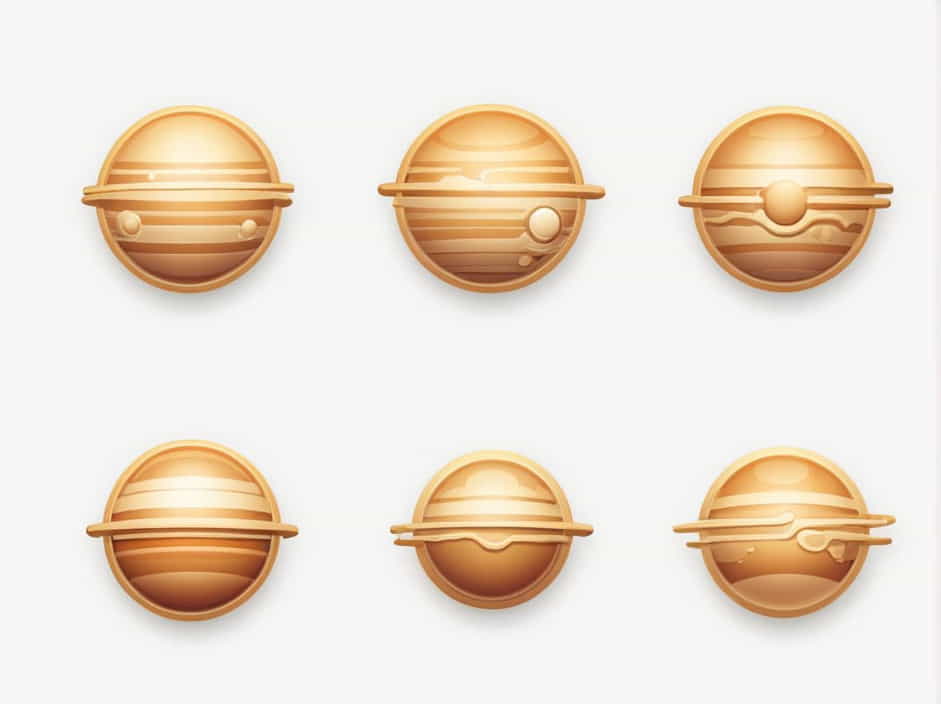Jupiter, the largest planet in the solar system, is a gas giant with no solid surface. Its composition and structure are vastly different from Earths, consisting of multiple layers that vary in density, temperature, and composition. Understanding Jupiter’s layers helps scientists learn more about planetary formation and atmospheric dynamics.
This content explores the layers of Jupiter from the outermost to the innermost, explaining their characteristics and importance.
1. Outer Atmosphere The Cloud Layers
Composition and Appearance
Jupiter’s outermost layer is its cloud-covered atmosphere, which is what we see from Earth. This layer consists of ammonia clouds, water vapor, and other compounds that create the planet’s iconic swirling bands and storms, including the famous Great Red Spot.
Main Features of the Cloud Layers
- Ammonia Clouds (Upper Layer) These white clouds are made of frozen ammonia crystals.
- Ammonium Hydrosulfide Clouds (Middle Layer) These brownish-red clouds contain sulfur-based compounds.
- Water Clouds (Lower Layer) Similar to Earths clouds but denser and deeper in Jupiters atmosphere.
The rapid winds and powerful storms in this region are driven by Jupiters internal heat and fast rotation. Unlike Earths atmosphere, which is mostly controlled by solar heating, Jupiter generates most of its own heat from within.
2. Upper Atmosphere The Troposphere
Beneath the visible clouds lies the troposphere, the most active region of Jupiters atmosphere. This is where massive storms and jet streams form, creating turbulent weather patterns.
Key Characteristics
- Temperature: -145°C (-234°F) at the top, increasing with depth.
- Pressure: Similar to Earths surface pressure at certain depths.
- Weather: Strong convection currents and lightning detected in deep cloud layers.
Scientists have found lightning storms in this layer, which suggests water-based weather systems similar to Earths but on a much larger scale.
3. Stratosphere
Below the troposphere is the stratosphere, where temperature increases with depth due to absorption of solar radiation and internal heat from Jupiters core.
Key Features of the Stratosphere
- Contains hydrocarbons such as methane and ethane, produced by ultraviolet radiation.
- Supports auroras near Jupiters poles, created by charged particles from the solar wind interacting with Jupiters strong magnetic field.
- Plays a role in Jupiters thermal balance, helping to regulate heat distribution.
Although it lacks the storms and turbulence of the troposphere, the stratosphere is essential in maintaining Jupiters climatic stability.
4. Thermosphere and Exosphere
The thermosphere and exosphere form the outermost layers of Jupiters gaseous envelope. These layers extend far into space and interact with the planets magnetosphere and solar radiation.
Key Features
- High temperatures exceeding 1,000°C (1,800°F) due to intense solar and magnetospheric heating.
- Contains charged particles from Jupiters strong magnetic field.
- Helps shape Jupiters auroras, some of the brightest in the solar system.
The exosphere gradually fades into interplanetary space, marking the transition between Jupiters atmosphere and the surrounding environment.
5. Metallic Hydrogen Layer
As we move deeper into Jupiter, the pressure increases so much that hydrogen gas is compressed into a strange state called metallic hydrogen.
What Is Metallic Hydrogen?
- Occurs at extreme pressures exceeding 1 million times Earths atmospheric pressure.
- Behaves like a metal, conducting electricity and generating Jupiters powerful magnetic field.
- Responsible for Jupiters intense magnetosphere, which extends millions of kilometers into space.
This metallic hydrogen ocean is unique to gas giants like Jupiter and Saturn, making them fundamentally different from terrestrial planets.
6. The Core Jupiters Mysterious Center
Jupiter’s innermost layer is its core, but scientists are still uncertain about its exact nature.
What Do We Know About Jupiters Core?
- Believed to be a dense, rocky, or icy core surrounded by a thick layer of metallic hydrogen.
- Estimated to be 1020 times the mass of Earth.
- Could be partially dissolved into the surrounding layers, making it less distinct than Earths solid core.
Recent data from NASAs Juno spacecraft suggests that Jupiters core might be diffuse and mixed with surrounding materials rather than a solid mass.
How Jupiters Layers Compare to Earths
| Layer | Jupiter | Earth |
|---|---|---|
| Atmosphere | Thick gas envelope with storms | Thin atmosphere with weather patterns |
| Stratosphere | Warmer than the troposphere, contains hydrocarbons | Ozone layer absorbs solar radiation |
| Thermosphere | Extremely hot due to magnetosphere | Heated by solar radiation |
| Metallic Hydrogen | Unique to gas giants, generates strong magnetic fields | Does not exist on Earth |
| Core | Possibly rocky, icy, or diffuse | Solid, iron-nickel core |
Jupiters lack of a solid surface makes it fundamentally different from Earth, but its layered structure follows similar physical principles related to pressure, temperature, and density.
Jupiter’s structure consists of multiple distinct layers, each playing a crucial role in the planets weather, magnetic field, and overall composition. From the swirling outer clouds to the mysterious core, every layer provides insights into the formation and evolution of gas giants.
Understanding Jupiters layers not only helps scientists learn about our solar systems largest planet but also offers clues about the atmospheres of exoplanets beyond our solar system. As spacecraft like Juno continue to explore Jupiter, we may soon uncover more secrets about this giant planets inner workings.
